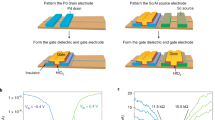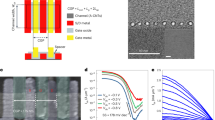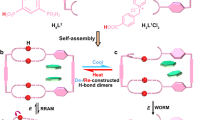Abstract
Over the past two decades, extensive research on single-walled carbon nanotubes (SWCNTs) has elucidated their many extraordinary properties1,2,3, making them one of the most promising candidates for solution-processable, high-performance integrated circuits4,5. In particular, advances in the enrichment of high-purity semiconducting SWCNTs6,7,8 have enabled recent circuit demonstrations including synchronous digital logic9, flexible electronics10,11,12,13,14 and high-frequency applications15. However, due to the stringent requirements of the transistors used in complementary metal–oxide–semiconductor (CMOS) logic as well as the absence of sufficiently stable and spatially homogeneous SWCNT thin-film transistors16,17,18, the development of large-scale SWCNT CMOS integrated circuits has been limited in both complexity and functionality19,20,21. Here, we demonstrate the stable and uniform electronic performance of complementary p-type and n-type SWCNT thin-film transistors by controlling adsorbed atmospheric dopants and incorporating robust encapsulation layers. Based on these complementary SWCNT thin-film transistors, we simulate, design and fabricate arrays of low-power static random access memory circuits, achieving large-scale integration for the first time based on solution-processed semiconductors.
This is a preview of subscription content, access via your institution
Access options
Subscribe to this journal
Receive 12 print issues and online access
$259.00 per year
only $21.58 per issue
Buy this article
- Purchase on Springer Link
- Instant access to full article PDF
Prices may be subject to local taxes which are calculated during checkout




Similar content being viewed by others
References
De Volder, M. F. L., Tawfick, S. H., Baughman, R. H. & Hart, A. J. Carbon nanotubes: present and future commercial applications. Science 339, 535–539 (2013).
Jariwala, D., Sangwan, V. K., Lauhon, L. J., Marks, T. J. & Hersam, M. C. Carbon nanomaterials for electronics, optoelectronics, photovoltaics, and sensing. Chem. Soc. Rev. 42, 2824–2860 (2013).
Tulevski, G. S. et al. Toward high-performance digital logic technology with carbon nanotubes. ACS Nano 8, 8730–8745 (2014).
Sangwan, V. K. et al. Fundamental performance limits of carbon nanotube thin-film transistors achieved using hybrid molecular dielectrics. ACS Nano 6, 7480–7488 (2012).
Ha, M. et al. Aerosol jet printed, low voltage, electrolyte gated carbon nanotube ring oscillators with sub-5 μs stage delays. Nano Lett. 13, 954–960 (2013).
Hersam, M. C. Progress towards monodisperse single-walled carbon nanotubes. Nature Nanotech. 3, 387–394 (2008).
Jin, S. H. et al. Using nanoscale thermocapillary flows to create arrays of purely semiconducting single-walled carbon nanotubes. Nature Nanotech. 8, 347–355 (2013).
Arnold, M. S., Green, A. A., Hulvat, J. F., Stupp, S. I. & Hersam, M. C. Sorting carbon nanotubes by electronic structure using density differentiation. Nature Nanotech. 1, 60–65 (2006).
Shulaker, M. M. et al. Carbon nanotube computer. Nature 501, 526–530 (2013).
Rogers, J. A., Someya, T. & Huang, Y. Materials and mechanics for stretchable electronics. Science 327, 1603–1607 (2010).
Sun, D.-M. et al. Mouldable all-carbon integrated circuits. Nature Commun. 4, 2302 (2013).
Wang, C. et al. User-interactive electronic skin for instantaneous pressure visualization. Nature Mater. 12, 899–904 (2013).
Cao, Q. et al. Medium-scale carbon nanotube thin-film integrated circuits on flexible plastic substrates. Nature 454, 495–500 (2008).
Chen, H., Cao, Y., Zhang, J. & Zhou, C. Large-scale complementary macroelectronics using hybrid integration of carbon nanotubes and IGZO thin-film transistors. Nature Commun. 5, 4097 (2014).
Steiner, M. et al. High-frequency performance of scaled carbon nanotube array field-effect transistors. Appl. Phys. Lett. 101, 053123 (2012).
Franklin, A. D. et al. Carbon nanotube complementary wrap-gate transistors. Nano Lett. 13, 2490–2495 (2013).
Franklin, A. D. et al. Variability in carbon nanotube transistors: improving device-to-device consistency. ACS Nano 6, 1109–1115 (2012).
Park, H. et al. High-density integration of carbon nanotubes via chemical self-assembly. Nature Nanotech. 7, 787–791 (2012).
Wang, H. et al. Tuning the threshold voltage of carbon nanotube transistors by n-type molecular doping for robust and flexible complementary circuits. Proc. Natl Acad. Sci. USA 111, 4776–4781 (2014).
Kim, B. et al. High-speed, inkjet-printed carbon nanotube/zinc tin oxide hybrid complementary ring oscillators. Nano Lett. 14, 3683–3687 (2014).
Lee, S. Y. et al. Scalable complementary logic gates with chemically doped semiconducting carbon nanotube transistors. ACS Nano 5, 2369–2375 (2011).
Zhang, W. et al. A 1 V printed organic DRAM cell based on ion-gel gated transistors with a sub-10nW-per-cell refresh power. Solid-State Circuits Conf. Dig. Tech. Papers 326–328 (2011).
Myny, K. et al. Microprocessor on plastic foil. IEEE J. Solid-State Circuits 47, 284–291 (2012).
Nah, J. et al. III–V complementary metal–oxide–semiconductor electronics on silicon substrates. Nano Lett. 12, 3592–3595 (2012).
Sekitani, T., Zschieschang, U., Klauk, H. & Someya, T. Flexible organic transistors and circuits with extreme bending stability. Nature Mater. 9, 1015–1022 (2010).
Derycke, V., Martel, R., Appenzeller, J. & Avouris, P. Controlling doping and carrier injection in carbon nanotube transistors. Appl. Phys. Lett. 80, 2773–2775 (2002).
Collins, P. G., Bradley, K., Ishigami, M. & Zettl, A. Extreme oxygen sensitivity of electronic properties of carbon nanotubes. Science 287, 1801–1804 (2000).
McClain, D. et al. Impact of oxygen adsorption on a population of mass produced carbon nanotube field effect transistors. Carbon 47, 1493–1500 (2009).
Geier, M. L. et al. Subnanowatt carbon nanotube complementary logic enabled by threshold voltage control. Nano Lett. 13, 4810–4814 (2013).
Aguirre, C. M. et al. The role of the oxygen/water redox couple in suppressing electron conduction in field-effect transistors. Adv. Mater. 21, 3087–3091 (2009).
Ding, L. et al. CMOS-based carbon nanotube pass-transistor logic integrated circuits. Nature Commun. 3, 677 (2012).
Acknowledgements
This work was supported by the Office of Naval Research MURI Program (N00014-11-1-0690) and the National Science Foundation (DMR-1006391, DMR-1121262 and CCF-0845605). A National Science Foundation Graduate Research Fellowship (M.L.G.) and a NASA Space Technology Research Fellowship (J.J.M.) are also acknowledged. Device fabrication was performed at the NUFAB cleanroom facility at Northwestern University.
Author information
Authors and Affiliations
Contributions
M.L.G., W.X., C.H.K. and M.C.H. conceived the experiments. M.L.G. fabricated the device, performed the electrical measurements, carried out the atomic force microscopy characterization and analysed and interpreted the data with input from C.H.K., T.J.M. and M.C.H. J.J.M. designed the TFT photolithography mask and wrote the data analysis program. W.X. and C.H.K. modelled the TFTs and SRAM circuits, and designed the photolithography mask for the SRAM circuits. J.Z. sorted the semiconducting SWCNTs and quantified the purity using UV–vis spectroscopy. The manuscript was written with contributions from all authors, and all authors approved the final version of the manuscript.
Corresponding author
Ethics declarations
Competing interests
The authors declare no competing financial interests.
Supplementary information
Supplementary information
Supplementary information (PDF 1440 kb)
Rights and permissions
About this article
Cite this article
Geier, M., McMorrow, J., Xu, W. et al. Solution-processed carbon nanotube thin-film complementary static random access memory. Nature Nanotech 10, 944–948 (2015). https://doi.org/10.1038/nnano.2015.197
Received:
Accepted:
Published:
Issue Date:
DOI: https://doi.org/10.1038/nnano.2015.197
This article is cited by
-
Carbon nanomaterials for sweat-based sensors: a review
Microchimica Acta (2024)
-
Scaling aligned carbon nanotube transistors to a sub-10 nm node
Nature Electronics (2023)
-
Wafer-scale transistor arrays fabricated using slot-die printing of molybdenum disulfide and sodium-embedded alumina
Nature Electronics (2023)
-
Air-stable n-type transistors based on assembled aligned carbon nanotube arrays and their application in complementary metal-oxide-semiconductor electronics
Nano Research (2022)
-
Emerging Internet of Things driven carbon nanotubes-based devices
Nano Research (2022)



